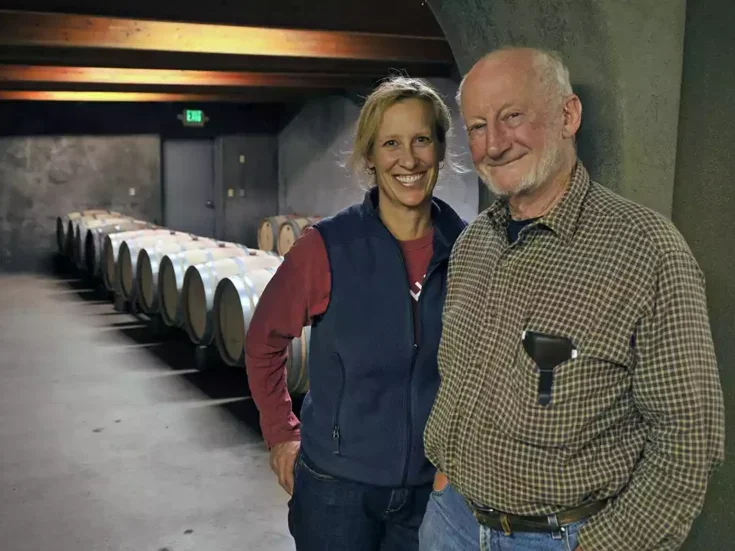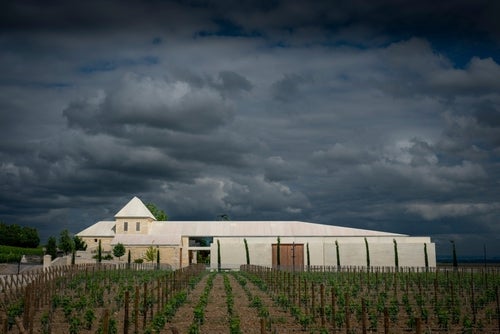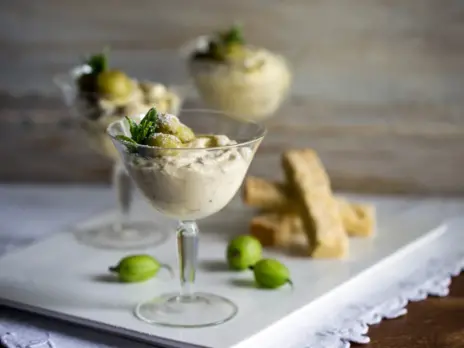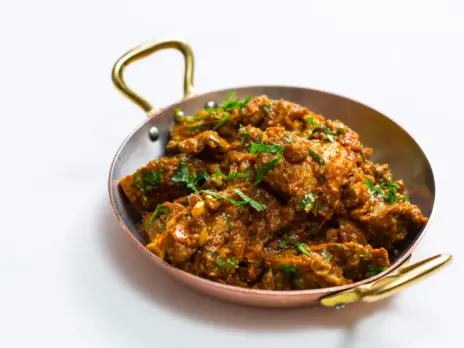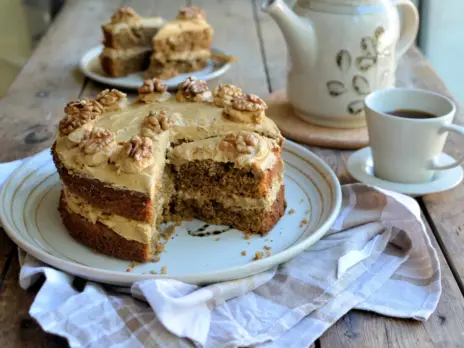
POMMARD
DOMAINE DU COMTE ARMAND
Paul Zinetti had a long harvest of two weeks, as they were picking only in the morning. They finished in Auxey-Duresses, in the village lieu-dit of Largillas: “It was less ripe than in 2020, but we finished here, so it was still very ripe and had a touch of shrivel.”
Paul didn’t do a green-harvest, which meant a lot of work on the sorting table. There was no proper cold facility, so he used plenty of dry ice for the whites in the press and afterwards for the débourbage. “I pressed the whites twice—first at less than 2 bar, then again at higher pressure. I want as much from the pulp as possible. But the débourbage was very important, as there was some mold, so I kept the must at 10 for two days, and the juice was very clean.” He inoculates the whites with cultured yeast. There is no chaptalization or acidification for red or white. The alcohol level for the whites was around 13%, with a pH of 3.2–3.3 before malo. “We had some malic, and the MLF took a long time.”
The reds were kept under CO2, for a coolish, pre-fermentation maceration. A couple of rack and returns, letting the fermenting juice settle to remove the lees, which were not wanted in 2023, given the conditions “We had a small 5hl tank in front of each vat and drained the wine into them, letting it settle overnight. But it was very difficult with the lack of space.” The alcohol level for the reds was 13.5–14%, with pHs of 3.4–3.5. Only Fremiets reached 3.6.
“The reds are rich—it’s not a classic vintage. It may be a bit like 2018, but I do not want to say 2018, even though I like 2018 now. More powerful than 2017. I like the note of Pinot Noir in this vintage.”
White
Aligoté
From three parcels; some young vines under Volnay and old vines below Meursault. Juicy and attractive, with neatly integrated acidity. A ripe Aligoté. Made in a combination of concrete tank, 600-liter oak barrels, and stainless steel. 2026–28. 82
Bourgogne Condemaine
From a parcel below Volnay. A small crop, as the vines are suffering on their rootstock: only two barrels. A slightly spicy palate, with attractive richness of texture and concentration. The pink-peppercorn note to the finish gives it lift. Alluring. 2025–28. 84–85
Red
Auxey-Duresses
From lieu-dit Largillas. Super-ripe strawberry fruit. Quite light-bodied, with just a waft of tannin. Easy-going. All in place now. Simple but nice. 2025–28. 82
Auxey-Duresses Premier Cru
A blend of one third Les Duresses and two thirds Les Bretérins, across a total of 0.28ha (0.75 acre), and the vines are 20–80 years old. Most of the young vines are in Bretérins, so it was a large crop. “On the sorting table, we took only the very best bunches.” Ripe, black-fruit aroma. Licorice on the palate, with quite robust tannins. It had a slightly astringent chewiness when I tasted it, but Paul was in no hurry to bottle this (he might wait until shortly before the 2025 harvest). As he pointed out, he doesn’t like to have empty barrels, which are better filled with wine than with SO2. 2027–30. 84
Pommard Premier Cru Clos des Epeneaux
Paul divides the vineyard into four. We tasted the separate components, including the press wine, which was much better than I expected, and then the blend, in the correct proportions.
1. S/E parcel. Red-cherry fruit and soft tannins.
2. S/W parcel. Super-rich and jammier. “From younger vines on SO4, which don’t have so many leaves, and the fruit was exposed to the sunshine,” says Paul.
3 N/W parcel. Rich and dense and slightly chewy in a good way.
4 N/E parcel. This is clearly the best wine. Smooth and generous and rich, and longest on the finish. To ferment this, Paul used a steel tank rather than wooden vats, which he has decide to replace.
Deep, blueberry-fruit aroma, with some red-cherry highlights. An elegant sweep into the palate, on ripe forest fruits. Smooth mid-palate, with just a light tannic grip. Quite nice intensity. Slight sapidity to the end, where there is a fresher bite. It’s very pleasant but lacks some dynamism. The N/E parcel provides the finish: “A difficult vintage, so I am happy with the Clos wine,” said Paul. 2027–35. 93
JEAN-MARC BOILLOT
Lydie and François Alzingre like to do an early harvest. They started on August 29, and harvest moved between reds and whites. The Mâcon is always harvested later. No green-harvest, but debudding. Yields for red were 50hl/ha, and for white, 55hl/ha (60hl/ha for village).
The whites are whole-bunch pressed, with 24 hours débourbage, and fermented in barrel using several different cultured yeasts. Bâtonnage every week for ten months and bottled in August. The use of Damy oak, 25% new, works well here on whites, which already have the richness of bâtonnage, and the oak effect is lightly creamy but discreet. 13.5–14% ABV for the whites. The domaine has 13ha (32 acres) in the Mâconnais, largely in the village of Chardonnay. They produce 80,000 bottles of Mâcon, of a total production of 300,000 bottles in a normal year. Norway is now the biggest market, with a thirst for Mâcon.
Lydie finds the 2023 whites most comparable with 2019 for quality. I preferred the whites to the reds—an attractive flight of Mâcon wines and good terroir distinction in the Puligny.
Among the reds, I preferred Pommard to Volnay—there is an excellent Pommard Rugiens. The new acquisition of land in Monthelie brings a rather attractive red to bridge the gap between Bourgogne and Volnay.
Reds are 100% destemmed. In 2023, there was a little pigeage for color and then remontage. Racked in October 2024 and put in tank until January 2025 for bottling.
“Juicy and fruity reds with good maturity,” says Lydie. “Maybe like 2020. Not the same structure, but for the first taste, more like 2019. For earlier dinking than 2022. Very nice young, and easy, but with good keeping potential.”
Bourgogne
From a parcel of older vines, around 60 years old, below Puligny, and a smaller parcel of younger vines under Volnay. Hazelnuts and apricots. So juicy, creamy, and ripe. An opulent, inviting, and really rather sumptuous Bourgogne, which tightens into a savory, mineral finish. Just delish. 2025–30. 86
Mâcon-Villages
Aged 70% in Damy barrels, of which 25% are new. Nice, aromatic, peachy fruit. Soft and juicy and very approachable. An attractive, easy-going wine. 2025–27. 82
Mâcon Chardonnay Les Berceau
From very close to Les Busserettes, but the soil is a deep white clay in a parcel located toward the top of a hill and southeast-facing. This is more compact than the Busserettes, showing tension and a sapid bite to finish. I like the colder, savory note. It has a light grip. The Mâcon mono-parcel wines are harvested the same day and made in the same way, so the difference is all in the terroir—and they are all very distinct, despite their close proximity. 2025–28. 85
Mâcon Chardonnay Les Busserettes
13.5% ABV. From a southeast-facing parcel, mid-slope, with a light, sandy, soil. A light litchee aroma, with a rather seductive, silky palate and, on the finish, a light salinity. More refined than the Mâcon-Villages. 2025–28. 83–84
Mâcon Luny Les Genièvres
From a parcel at the bottom of the hill, with white clay. White-peach and floral notes. Rounded, full, generous, and perfumed, with a lightly exotic scent on the finish. Charming. 2025–29. 82–83
Montagny Premier Cru
A négoce wine, bought as must, from five different growers with whom they have been working for 25 years. 30,000 bottles. Ripe, greengage, slightly spicy fruit. Succulent and splashing, with sufficient acidity cutting through the rich fruit, so it is fresh on the finish, where a touch of oak works to lift it further. 2025–29. 83–84
Puligny-Montrachet
From seven parcels—five in Enseignières, one in Clos des Meix, and one in Rue Rousseau—each vinified and aged separately. A rich and creamy Puligny, which cuts into a silky and smooth, mineral finish that carries well. Very appealing. 2025–32. 89–90
Puligny-Montrachet Premier Cru Champ Canet
More tropical on the nose than the Referts. Super-juicy, generous, and relatively fresh. It has an airy and rounded feel. Light on its feet and the finish is salty and pure. 2025–32. 93
Puligny-Montrachet Premier Cru Combettes
A rich and full, dense wine. A touch heady, with the 14% ABV, which shows a little, but it is compact and has an almost chewy palate. Full-bodied, layered, punchy and powerful, pushing through on the finish. A good Combettes, which needs to settle down. Lydie compares the ’23 whites with 2019—and with this Combettes, I can see the correlation. 2028–38. 94
Puligny-Montrachet Premier Cru Les Referts
A deep and punchy, quite earthy aroma, then on the palate, it is full-bodied and broad. 14% ABV. Succulent and loose, and a little louche for Puligny, but it shapes up to a saltier finish. I might like more freshness, but this will have wide appeal. 2026–32. 92–93
Puligny-Montrachet Premier Cru La Truffière
“It is very dry here, and the vines suffer when it is hot with no rain, but now the wine is open young—we always had to wait in the past.” Floral and pure. An upright aroma. On the palate, this is streamlined, zesty, and nervy on the finish. It is delicate and precise. A delightful, white-flower note lingers on the finish. 2026–32. 95
Red
Bourgogne
Made with fruit from the Mâconnais (and it’s Pinot Noir). Nice and juicy and accessible. Soft tannins and just very approachable. 2025–27. 82
Monthelie Les Sous Roche
The domaine purchased this 0.5ha (1.2-acre) vineyard, with 40-year-old vines, in 2023, its first vintage: “Affordable land, not like the prices in Meursault,” says Lydie. Red and white. Bright and crunchy, with a nice, fresh, snappy character. Slightly herbal, but on the good side of green. Pleasing. 2025–27. 83
Pommard
From a 0.05ha (0.12-acre) clos, without a lieu-dit, which is effectively the garden beside the house. A red-fruity wine, which has a light grip of tannin. A nice bite and crunch to the end. Dark-cherry fruit. It is lightly robust and rather appealing. 2026–29. 87
Pommard Premier Cru Rugiens
From old vines in Rugiens-Bas: three barrels, which is a good harvest there. A big level up on the other reds I tried. It has silky tannins and intensity. A fine and elegant profile to an extended and supple finish. A river of silk and pure, lucid fruit. What a lovely example. 2026–35. 94–95
Volnay Premier Cru Carelle Sous la Chapelle
Picked on August 29: “We started harvesting with the Volnay premier cru reds,” explained Lydie. A very ripe aroma, with baked cherry-pie fruit. It is loose and open-textured. Easy-going, a little rustic maybe. I prefer the Pitures. 2026–38. 88
Volnay Premier Cru Pitures
Ripe, red-fruit aroma. This is super-ripe, with red summer fruits, light, crisp, and lightly snappy on the finish. Modest intensity, but I like the minerality. 2025–29. 88–89
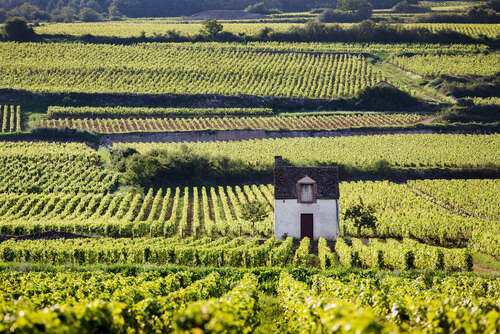
DOMAINE DE COURCEL
Yves Confuron, who manages this estate in addition to his own in Vosne, considers that in 2023, “Pommard has made the more beautiful wine. In hot vintages, we make better wine in cold appellations like Pommard.”
“There was half as much rain in Pommard as on the Côte de Nuits in August. So, there were more dehydrated berries in Pommard, and less concentration in Vosne. It was very hot, which was very good for the quality of the tannins in Pommard, if you waited.” He harvested September 20–30. Yields were 32–33hl/ha. “Some very old vineyards. There really were not a lot of grapes.”
He found it “impossible to cool the fruit, but with the whole-bunch, the fermentation is not quick.” Yves never racks during the aging period, which is now 36 months. “We lose some fruit aroma, but the tannins become finer. I think most people keep wines in barrel for too short a time. People make wine for the market, with good, fruity aromas, but perhaps less terroir expression.
“There is concentration and freshness in this vintage. Freshness is not necessarily about acidity. You can make wine with really good ripeness, and it can still have freshness. And 2023 has crunchy freshness. It is ripe and fresh and well-balanced.”
These are opulent, black-cherry-ripe Pommards, with notable concentration. Rich in ripe tannin and alcohol—14.5% ABV—but with freshness coming from the whole-bunch. A dense and sumptuous profile—wines that will need more time in bottle than most this vintage, but that have the structure to age very well.
Bourgogne
From a parcel just under the Château de Pommard. Dense, rich, and generous, in a spicy, black-fruit style. A lot of wine and matter for a Bourgogne. Punches above its appellation. 2027–32. 86–87
Pommard Vaumuriens
From a cool lieu-dit with white soil. “If we planted Chardonnay here, it would make very good wine,” said Yves, handing me a ball of white clay from the vineyard. Floral notes. Very rich. Supple tannin, Christmas spices. Generous, smooth, and silky, then on the finish it has freshness and a line of sapidity. 2028–35. 88
Pommard Premier Les Croix-Noires
Courcel owns half of this 1.2ha (3-acre) vineyard, with brown clay and deeper soil than Fremiers. Deep and juicy. Full and dark. Chewy tannin. A bold and licorice wine. “Always one direction—black fruit, with strong tannins.” Old-school Pommard style, but riper. 2029–35+. 92
Pommard Premier Cru Les Fremiers
Compact and yet quite silky into the palate, where it picks up some tension and sapidity. Ripe but energetic and, on the finish, a nice, stemmy note; a green freshness. It is more refined than the Croix-Noires, although the parcels are just 50m (165ft) apart. Light oregano notes to finish. 2029–35+. 93–94
Pommard Premier Cru Grand Clos des Epenots
Dark chocolate and mint on the nose. Richly satin fluidity of tannin. A ribbon of fruit, black cherries and a touch of kirsch. Concentrated, and there’s suavity to the persistent finish. It is very rich, but it has proper Epenots personality and intensity, which most Epenots seem to lack this vintage. So, bravo to Yves. Not everyone likes his style of wine, but he has produced a very good Epenots. 2030–40. 95
Pommard Premier Cru Rugiens
Rugiens has a ripe cherry aroma, with garden herbs and spices, and it attacks the palate with a pounce. For a rich wine, this has plenty of energy. A firm line of freshness and tension, and the finish is persistent. The tannins are firm and plentiful but fine-textured. 2030–40. 95
DOMAINE DU PAVILLON
Another of Bichot’s estates: 16ha (40 acres), certified organic. Bichot’s technical director, Matthieu Mangenot, explains that they did a strict green-harvest for reds, starting in early-July, and changed the normal picking order across the various domaines, starting, usually, with the whites. “The most significant points in managing this vintage were the green-harvest and sorting of the reds, and for both colors, reducing the aging time and the proportion of new oak.” Matthieu find the reds “like 2018, for the warm character. Without the structure of 2020, but with a hint of the delicacy of 2016.” While joint-technical director Cyrille Jacquelin finds them most like 2018, adding, “The whites are more concentrated—they are like 2019, with less alcohol and heaviness.”
White
Meursault Premier Cru Les Charmes
From two parcels in Charmes-Dessus and one in Charmes-Dessous, 1.2ha (3 acres) in total. Ripe, citrus aroma and a glossy, slightly tropical, full and rounded palate, but beneath this and on the finish is a line of freshness. After the rich start, some tension is present. 2025–30. 91–92
Corton-Charlemagne Grand Cru
From 1.2ha (3 acres) in Languettes. 30% new oak. This was to be bottled in December 2024. The ripe citrus fruit has an engaging, pure tone as it hits the palate. Rich but channeled, deep and straight. There is some vigor. An attractive, lemon-pith note mid-palate, and the sweet and salty finish has decent persistence. 2026–32. 93
Red
Aloxe-Corton Premier Cru Clos des Maréchaudes (Monopole)
This wine comes from the 1.4ha (3.5-acre) section of premier cru in the lower part of this 5ha (12-acre) clos, entirely owned by Bichot; the grand cru section lies above. A chunky wine, generous and full. It’s quite exotic, with notes of dried fruit and toasted cumin, cinnamon, and a rich lick of licorice. Soft and sweet tannins. 2026–30. 87–88
Pommard Premier Cru Les Rugiens
From a 0.33ha (0.75-acre) parcel. This has a spicy lift to the aroma. I like the fresh nose, with its forest fruit and a hint of herbs and pepper. A sweet and fluid ripple into the palate; this flows easily along, on light, fine-textured tannins. There is a nice thread of freshness through the fruit, too, and it wafts gently into the finish. For Rugiens, it is light and approachable, without the muscle you mighty normally expect, but that said, it’s a charming and well-balanced wine. 2025–30. 92
NANTOUX
DOMAINE BORIS CHAMPY
Boris Champy makes his biodynamic wines in Nantoux. “2023 was a small production—less than 2022—because of the green-harvest.” Top-notch Hautes-Côtes.
White
Bourgogne Hautes-Côtes de Beaune Aligoté Doré
Half from very old vines and half from massal selection vines planted in the mid-1980s and 1997. A rather sumptuous and gregarious Aligoté, with a lively line of minerality. 2025–28. 84
Bourgogne Hautes-Côtes de Beaune Blanc Montagne 382
From the Montagne de Cras lieu-dit, which lies at 382m (1,250ft). Ripe and yet super-zesty on the attack. A neatly compact mid-palate, then savory to finish, with slightly silex, smoky notes. 2025–30. 85
Bourgogne Hautes-Côtes de Beaune Blanc Montagne 382 Presse Vertical
This version is from a vertical press, and from the slow, gentle pressing, Boris takes clear juice, which didn’t need settling. Matured in barrels, some of which are new. Lime-fresh and pure, this is straighter and racier than the previous wine. Crisply edged and straight, with a precise and delicate finish. 2025–28. 86
Red
Coteaux Bourguignons
From old vines, planted in 1980, with some replanting. 50% whole-bunch. Boris adds some fresh fruit a few days after the start of the fermentation to prolong it. Red-berry fruit, soft and yet bright. It’s light, with quite a delicate texture. 2025–27. 81
Bourgogne Hautes-Côtes de Beaune Altitude
A blend of the youngest vines from Bignon and Le Clou. Sprightly across the palate, with herbal freshness. A crunchy texture and slightly austere snap. 2025–27. 82–83
Bourgogne Hautes-Côtes de Beaune Bignon 421
From a parcel on red clay at the top of the slope and on a plateau. The aroma is dark and spicy. Punches on the palate. Full-bodied. Grippy tannin and meatiness, with a slightly exotic note. Grunty finish. 2026–30. 85
Bourgogne Hautes-Côtes de Beaune Clou 377
Au Clou is marly. Snappy tannins and a clean cut of savory minerality. I like the austerity and lively line. The salty finish is pure, tight, and has salinity. Boris says it is a very good terroir for whole-bunch. 2026–30. 86
2023 Burgundy: Abundant variability
2023 Burgundy: A guide to the villages and vineyards
2023 Burgundy: Chablis with a sunny disposition
2023 Burgundy: Chablis tasting notes
2023 Burgundy tasting notes: Côte de Nuits—Marsannay and Fixin
2023 Burgundy tasting notes: Côte de Nuits—Gevrey-Chambertin
2023 Burgundy tasting notes: Côte de Nuits—Morey-St-Denis
2023 Burgundy tasting notes: Côte de Nuits—Nuits-St-Georges
2023 Burgundy tasting notes: Côte de Beaune—Beaune


